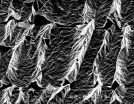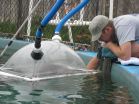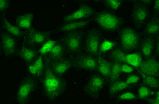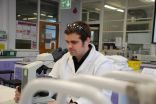(Press-News.org) PROVIDENCE, R.I. [Brown University] -- Using a technique that introduces tiny wrinkles into sheets of graphene, researchers from Brown University have developed new textured surfaces for culturing cells in the lab that better mimic the complex surroundings in which cells grow in the body.
"We know that cells are shaped by their surroundings," said Ian Y. Wong, assistant professor of engineering and one of the study's authors. "We've shown that you can make textured environments for cell culture fairly easily using graphene."
Traditionally, cell culture in the lab has been done in petri dishes and on other flat surfaces. But in the body, cells grow in considerably more complex environments. Research has shown that a cell's physical surroundings can influence its shape, physiology, and even the expression of its genes. That has led scientists in the last decade or so to look for ways of culturing cells in laboratory settings that are a bit more complex.
Making surfaces with textures small enough to be relevant at the cellular scale isn't easy, however. So the Brown team turned to a darling of the nanotech world: graphene, the carbon nanomaterial.
To make their textured surfaces, the researchers used graphene oxide dispersed in a solution and dabbed onto a substrate made from a rubbery silicon material. Before applying the graphene, tension is applied to the substrate to stretch it out like a rubber band. When the graphene dries, the tension is released and the substrate snaps back to its normal size. When that happens, tiny wrinkles -- ridges just a few microns high and spaced a few microns apart -- form in the graphene layer atop the substrate.
The size of the wrinkles can be controlled by the concentration of the graphene solution and the extent of the substrate stretching. A more concentrated solution increases the spacing between the wrinkle ridges. More stretching increases the height of the wrinkles.
Part of the beauty of these surfaces is the ease with which they can be made, says Mehrdad Kiani, a Brown undergraduate student and member of the research team.
"Other methods are much more labor-intensive," Kiani said. "With this method, you can take a long piece of rubber substrate, stretch it out, and place many droplets at once." The long ribbon can then be cut into small rectangles, which can be placed in multiwell plates for lab experiments.
Once they had their wrinkled surfaces, the researchers' next step was to see whether those wrinkles influenced the growth of cells cultured on the surfaces. In a study published recently in the journal Carbon, the team grew human and mouse fibroblast cells (cells involved in wound healing) on flat graphene sheets and on wrinkled ones. The study revealed major differences in how cells grew on each of the surfaces.
"On the flat graphene, the cells were disorganized, multipolar and not aligned," said Evelyn Kendall Williams, another undergraduate member of the research team. "But on the wrinkled surface, the cells were elongated and highly aligned along the wrinkles. These morphological features are more indicative of a biologically relevant phenotype."
In the body, fibroblasts grow in the nooks and crannies of connective tissue. They tend to tend to have a long, spindly appearance similar to the look of the cells that grew in the graphene wrinkles.
Having shown that their wrinkled surface can influence the shape of cells, the researchers will continue to do experiments with wrinkles of different shapes and sizes. These surfaces make that possible because the wrinkles themselves are easily tunable. "We think this is a great new way to understand how cells' growth is influenced by their physical surroundings," Wong said.
The surfaces could also be used to test drugs in the lab, Wong says, or perhaps as biomimetic surfaces for implantable tissue scaffolds or neural implants.
The work was the result of collaboration between Wong's biomedical engineering lab and the lab of Robert Hurt, professor of engineering at Brown, who focuses on carbon nanomaterials.
"This is a new application for graphene," Hurt said. "We are just beginning to realize all of the innovative ways one can use this atomically thin and flexible building block to make new materials and devices."
INFORMATION:
The team recently received seed funding from Brown's Office of the Vice President for Research to continue the work.
Kiani and Williams both received undergraduate research funding from Brown to work on the project during the summer of 2014. Kiani was funded through the Vincent and Ruby DiMase Undergraduate Summer Fellowship offered through the Brown School of Engineering. Williams received a Karen T. Romer Undergraduate Teaching and Research Award.
Graduate students Zhongying Wang, Daniel Tonderys, Susan E. Leggett, Ruben Spitz Steinberg, and Yang Qiu were coauthors on the paper. The initial work was supported by the National Science Foundation (CBET-1132446 and CBET-1344097) and National Institutes of Health (5T32ES007272-23); Wong received seed funding from Jason and Donna McGraw Weiss.
An enzyme secreted by the body's fat tissue controls energy levels in the brain, according to new research at Washington University School of Medicine in St. Louis. The findings, in mice, underscore a role for the body's fat tissue in controlling the brain's response to food scarcity, and suggest there is an optimal amount of body fat for maximizing health and longevity.
The study appears April 23 in the journal Cell Metabolism.
"We showed that fat tissue controls brain function in a really interesting way," said senior author Shin-ichiro Imai, MD, PhD, professor of ...
Dolphins that raise their voices to be heard in noisy environments expend extra energy in doing so, according to new research that for the first time measures the biological costs to marine mammals of trying to communicate over the sounds of ship traffic or other sources.
While dolphins expend only slightly more energy on louder whistles or other vocalizations, the metabolic cost may add up over time when the animals must compensate for chronic background noise, according to the research by scientists at NOAA Fisheries' Northwest Fisheries Science Center and the University ...
TORONTO, ON. (23 April, 2015) - A new study led by University of Toronto researcher Dr. David Lam has discovered the trigger behind the most severe forms of cancer pain. Released in top journal Pain this month, the study points to TMPRSS2 as the culprit: a gene that is also responsible for some of the most aggressive forms of androgen-fuelled cancers.
Head of Oral and Maxillofacial Surgery at the Faculty of Dentistry, Lam's research initially focused on cancers of the head and neck, which affect more than 550,000 people worldwide each year. Studies have shown that these ...
ROCHESTER, Minn. -- A 47-year-old African-American woman has heavy menstrual bleeding and iron-deficiency anemia. She reports the frequent need to urinate during the night and throughout the day. A colonoscopy is negative and an ultrasonography shows a modestly enlarged uterus with three uterine fibroids, noncancerous growths of the uterus. She is not planning to become pregnant. What are her options?
Elizabeth (Ebbie) Stewart, M.D., chair of Reproductive Endocrinology at Mayo Clinic, says the woman has several options, but determining her best option is guided by her ...
ANN ARBOR--Use of clean fuels and updated pollution control measures in the school buses 25 million children ride every day could result in 14 million fewer absences from school a year, based on a study by the University of Michigan and the University of Washington.
In research believed to be the first to measure the individual impact on children of the federal mandate to reduce diesel emissions, researchers found improved health and less absenteeism, especially among asthmatic children.
A change to ultra low sulfur diesel fuel reduced a marker for inflammation in ...
Boosting teenagers' ability to cope with online risks, rather than trying to stop them from using the Internet, may be a more practical and effective strategy for keeping them safe, according to a team of researchers.
In a study, more resilient teens were less likely to suffer negative effects even if they were frequently online, said Haiyan Jia, post-doctoral scholar in information sciences and technology.
"Internet exposure does not necessarily lead to negative effects, which means it's okay to go online, but the key seems to be learning how to cope with the stress ...
CAMBRIDGE, Mass--Drizzling honey on toast can produce mesmerizing, meandering patterns, as the syrupy fluid ripples and coils in a sticky, golden thread. Dribbling paint on canvas can produce similarly serpentine loops and waves.
The patterns created by such viscous fluids can be reproduced experimentally in a setup known as a "fluid mechanical sewing machine," in which an overhead nozzle deposits a thick fluid onto a moving conveyor belt. Researchers have carried out such experiments in an effort to identify the physical factors that influence the patterns that form. ...
April 23, 2015 - Interventional treatments--especially surgery--provide good functional outcomes and a high cure rate for patients with lower-grade arteriovenous malformations (AVMs) of the brain, reports the May issue of Neurosurgery, official journal of the Congress of Neurological Surgeons. The journal is published by Wolters Kluwer.
The findings contrast with a recent trial reporting better outcomes without surgery or other interventions for AVMs. "On the basis of these data, in appropriately selected patients, we recommend treatment for low-grade brain AVMs," concludes ...
A new study by the University of Chicago Booth School of Business Assistant Professor Amanda Sharkey and University of Utah Assistant Professor Patricia Bromley found that environmental ratings have spillover effects on other companies' behavior. Rated firms reduce their toxic emissions even more when their peers are also rated. In addition, rated peers can even motivate some unrated companies to reduce their emissions.
The research is unusual in that the role of peers in conditioning how firms respond to ratings systems has received little examination.
The study, "Can ...
SINCE its first use in the 1980s - a breakthrough dramatised in recent ITV series Code of a Killer - DNA profiling has been a vital tool for forensic investigators. Now researchers at the University of Huddersfield have solved one of its few limitations by successfully testing a technique for distinguishing between the DNA - or genetic fingerprint - of identical twins.
The probability of a DNA match between two unrelated individuals is about one in a billion. For two full siblings, the probability drops to one-in-10,000. But identical twins present exactly the same ...




